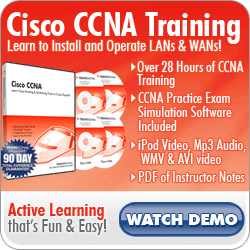
Hiya Bulldogs! :)
As mentioned in the next blog post down, I will be catching up on the Cisco certification Video Practice Exams I owe all my Bulldogs out there... but in the meantime, I'll post the questions here so you can have a little sneak peek at the questions!
Here are several CCNA and CCNP practice exams - I'll have four brand-new videos here on the Bulldog Blog on Wednesday showing you the answers on real Cisco rouers and switches! Enjoy, and I'll see you Wednesday with the answers!
Practice Exam #1:
Question 1:
The number in the "router eigrp" command represents what?
A. Nothing - there isn't such a number.
B. The AS number
C. The area number
D. The wildcard number
E. The administrative distance
Question 2:
Which of the following best describes the use of wildcard masks in EIGRP?
A. nonexistent
B. required
C. optional
D. None of these terms describes the use of wildcard masks in EIGRP
Question 3:
Which of the following describes the use of wildcard masks in OSPF?
A. nonexistent
B. required
C. optional
D. indicates the area
Question 4:
Which of the following describes the use of wildcard masks in RIP?
A. nonexistent
B. used in Version 2, not in Version 1
C. optional
D. used in both versions
E. required
Cisco Practice Exam #2:
Question 1:
Which of the following OSPF network types have no Designated Router?
A. broadcast
B. multicast
C. point-to-point
D. point-to-multipoint
Question 2:
Which of the following correctly describes an OSPF broadcast network?
A. Will elect a DR and BDR
B. Will elect neither a DR nor a BDR
C. Dead time is 30 seconds
D. Hello time is 30 seconds
Question 3:
Which of the following describes an OSPF "internal router"?
A. All interfaces must be in Area 0
B. All interfaces are in the same area
C. Will have only a default OSPF route in the routing table
D. Will have a default OSPF route to reach destinations in Area 0, but specific routes to external destinations
Question 4:
Which of the following will result in an OSPF router becoming an "ASBR"?
A. Being made the hub of an NBMA network
B. Performing route redistribution
C. Being made the DR of a point-to-point network
D. Being made the BDR of a point-to-point network
Answers will be posted here on the Bulldog Blog on Tuesday, along with an accompanying Video Practice Exam. Just scroll down for the next practice exam!
Get A Free CCNA Security Study Package ($67 Value) With Any Of My Cisco Certification Video Boot Camps - And Free Shipping, Too! Click Any Of These Banners And You're On Your Way To Certification Exam Success!
For A Limited Time, You Also Receive A Free Windows Server 2008 R2 Training Course With Every Order!
Cisco Practice Exam #3:
Question 1:
What is a "broadcast storm"? Are they to be avoided or encouraged? And why?
(Yes, I realize that's three questions. :) )
Question 2:
Which of the following terms best describes how broadcast storms occur?
A. suddenly
B. gradually
C. due to STP
D. due to CDP
Question 3:
Which of the following Frame Relay "map" options enables the transport of multicasts?
A. broadcast
B. multicast
C. interface-dlci
D. You need a frame map statement pointing to the multicast address to be carried - 224.0.0.5 for OSPF Hellos, for example.
Question 4:
A debug of which of the following protocols will display a broadcast address?
A. RIP v1
B. RIP v2
C. OSPF
D. EIGRP
E. floating static route
Answers right here on Tuesday - and just scroll down for the next Cisco practice exam!
Five Minutes From Now, You Can Use My PROVEN Cisco Study Packages To Prepare For Exam And Real-World Success -
And You Also Receive A Free CCNA Security Study Package (A $67 Value) With Your Immediate Download Of My CCNA And CCNP Study Packages!
Just Click These Banners And You're On The Way To Success In The Real World AND The Exam Room!
For A Limited Time - Receive Three Free Days Of CCNP Rack Time For BSCI And BCMSN Labs, A $37 Value, FREE With This Exclusive Bundle! It's Yours In Minutes After You Order - Click This Banner And Let's Get Started On The Way To Your CCNP!
Cisco Practice Exam #4:
Question 1:
What command places a trunk port into an Etherchannel?
Question 2:
When you create an Etherchannel, is the port cost different than that of the physical ports involved?
A. No, it's the same.
B. Yes, it's higher.
C. Yes, it's lower.
D. Etherchannels do not have port costs.
Question 3:
You've created an Etherchannel and run "show interface trunk". You see nothing where you previous saw the individual trunk ports.
Is this normal, or does this indicate a problem?
Question 4:
You have three ports inside an Etherchannel on a given Cisco switch. One port goes down. Which of the following will happen?
A. The EC port cost will rise.
B. The EC port cost will decline.
C. The EC port cost will be non-existent, since the EC will go down.
D. The EC port cost will remain the same.
I'll see you Wednesday with the answers to all of these questions - illustrated on REAL Cisco routers and switches!
Chris Bryant
CCIE #12933
"The Computer Certification Bulldog"











Comments